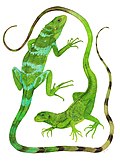This is an old revision of this page, as edited by Jongleur100 (talk | contribs) at 15:19, 2 April 2009 (Reverted 2 edits by 75.144.160.241 identified as vandalism to last revision by Alansohn. (TW)). The present address (URL) is a permanent link to this revision, which may differ significantly from the current revision.
Revision as of 15:19, 2 April 2009 by Jongleur100 (talk | contribs) (Reverted 2 edits by 75.144.160.241 identified as vandalism to last revision by Alansohn. (TW))(diff) ← Previous revision | Latest revision (diff) | Newer revision → (diff)| Iguana | |
|---|---|

| |
| Green Iguana Iguana iguana | |
| Scientific classification | |
| Kingdom: | Animalia |
| Phylum: | Chordata |
| Class: | Sauropsida |
| Order: | Squamata |
| Suborder: | Iguania |
| Family: | Iguanidae |
| Genus: | Iguana Laurenti, 1768 |
| Species | |
| |
Iguana is a genus of lizard native to tropical areas of Central and South America and the Caribbean. The genus was first described by Austrian naturalist Josephus Nicolaus Laurenti in his book Specimen Medicum, Exhibens Synopsin Reptilium Emendatam cum Experimentis circa Venena in 1768. The genus Iguana includes two species: the green iguana (a popular pet) and the lesser Antillean iguana.
The word "Iguana" is derived from a Spanish form of the original Taino name for the species "Iwana".
Anatomy and physiology
The two species of lizard within the genus Iguana possess a dewlap, a row of spines running down their back to their tail, and a third "eye" on their head. This eye is known as the parietal eye, visible as a pale scale on the top of the head. Behind their neck are small scales which resemble spikes, known as tuberculate scales. They also have a large round scale on their cheek known as a subtympanic shield.
Iguanas have excellent vision and are able to see shapes, shadows, color and movement at long distances. Iguanas use their eyes to navigate through crowded forests, as well as for finding food. They also use visual signals to communicate with members of the same species.
They respond to visual stimulus of colors such as orange,yellow,pink, and in rare cases blue as food substances.
An iguana's ear is known as the tympanum. It is the iguana's ear drum, and is located right above the subtympanic shield and behind the eye. The color green helps as a mode of hiding.
Gallery
-
 A green iguana (Iguana iguana)
A green iguana (Iguana iguana)
-
This is a green iguana kept as a pet.
- This is a lesser Antillean iguana kept at a zoo. This is a lesser Antillean iguana kept at a zoo.
-
 A green iguana (Iguana iguana)
A green iguana (Iguana iguana)
-
 Another green iguana (Iguana iguana)
Another green iguana (Iguana iguana)
-

References
- Coles, William (2002), "Green Iguana" (PDF), U.S.V.I. Animal Fact Sheet #08, Department of Planning and Natural Resources US Virgin Islands Division of Fish and Wildlife
Bibliography
| Iguanidae | ||||||||||||||||||||||||
|---|---|---|---|---|---|---|---|---|---|---|---|---|---|---|---|---|---|---|---|---|---|---|---|---|
| ||||||||||||||||||||||||
